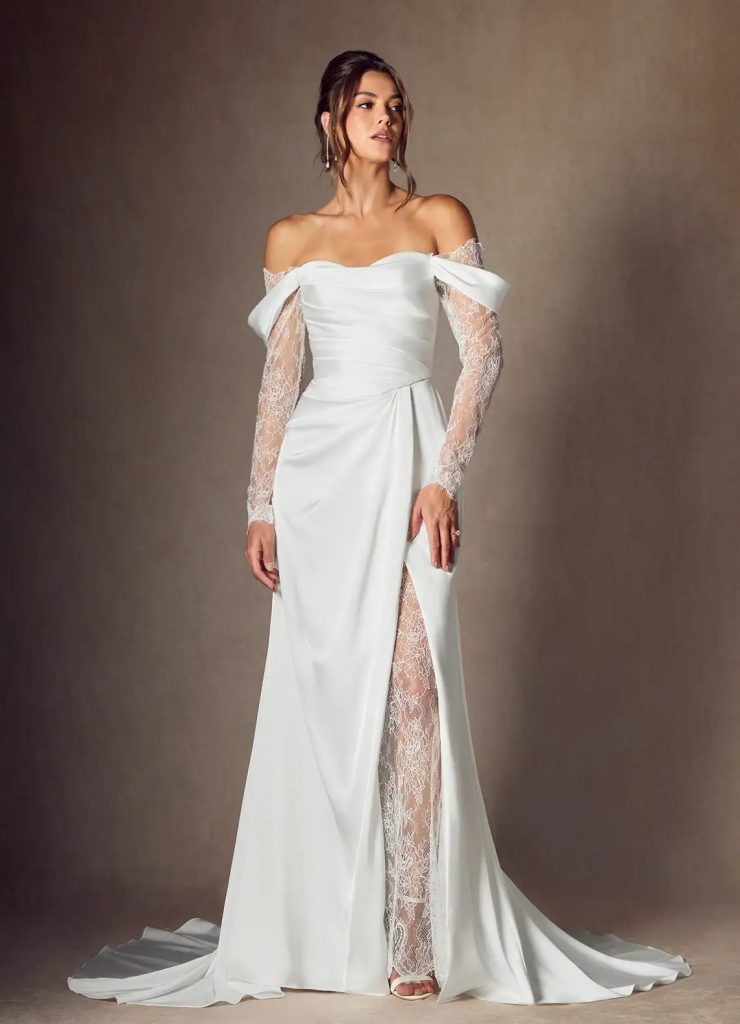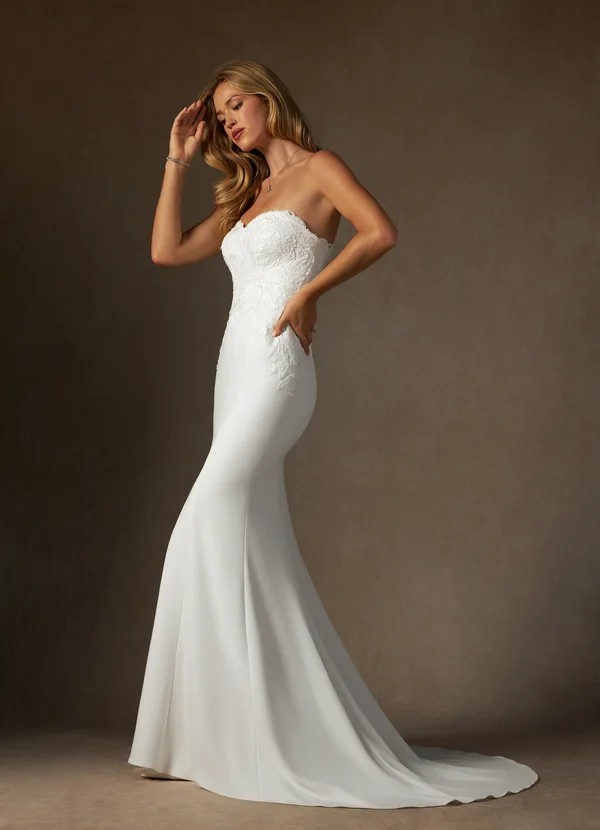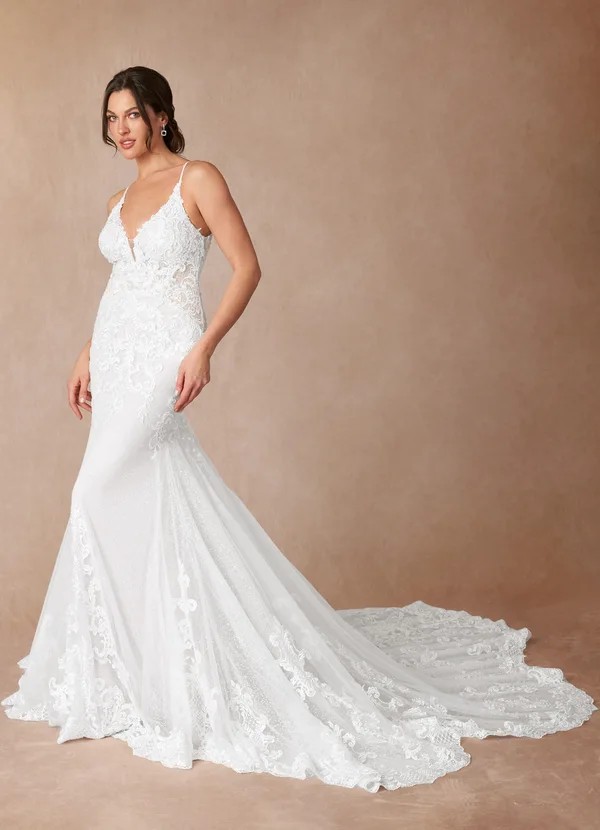How Do I Choose the Right Size for My Wedding Dress?

Finding your dream wedding dress is only half the journey — the right size and fit make it truly perfect.Every bride’s body is unique, and bridal sizing can differ significantly from regular clothing sizes.
Choosing the right size for your wedding dress ensures comfort, confidence, and effortless movement on your big day.Let’s explore exactly how to measure yourself, interpret bridal size charts, and make smart choices when ordering your gown.
Why Bridal Sizing Is Different
- Bridal sizes run smaller than street sizes — you may wear one or two sizes up from your usual clothing.
- Bridal gowns are made to fit the largest part of your body (bust, waist, or hips).
- Alterations are expected and normal — dresses are designed with extra seam allowance for adjustments.
- Each designer’s size chart can vary, so always refer to the brand’s own measurements.
Tip: Always focus on measurements, not the number on the tag.
Step-by-Step: How to Measure Yourself Correctly

Before you order, accurate measurements are key. Use a soft measuring tape, stand straight, and measure over light clothing.
Essential Measurements
| Area | How to Measure | Tips |
| Bust | Measure around the fullest part of your bust, keeping tape parallel to the floor. | Keep arms relaxed at sides. |
| Waist | Find the narrowest part of your torso (above the belly button). | Don’t suck in; stay natural. |
| Hips | Measure the fullest part of your hips and rear. | Stand with feet together. |
| Hollow to Hem | From the hollow (dip) at the base of your neck to the floor. | Wear your wedding shoes for accuracy. |
| Height | From top of head to floor (barefoot). | Needed for dress length calculations. |
Bridal Measurement Reference Table
| Measurement | US Size 4 | US Size 6 | US Size 8 | US Size 10 | US Size 12 |
| Bust (inches) | 33 | 34 | 35 | 36 | 37.5 |
| Waist (inches) | 25.5 | 26.5 | 27.5 | 28.5 | 30 |
| Hips (inches) | 36 | 37 | 38 | 39 | 40.5 |
| Hollow to Hem (inches) | 58 | 58 | 59 | 59 | 60 |
How to Choose Between Two Sizes
If your measurements fall between sizes:
- Choose the larger size. It’s easier to take a dress in than let it out.
- Consider your fabric. Stretch materials (like crepe or satin) allow a tighter fit.
- Account for alterations. Seamstresses can fine-tune the fit closer to your body shape.
Key Rules for Selecting Wedding Dress Size

- Always measure at least twice before confirming.
- If possible, have a friend or professional measure you.
- Match your size to the largest measurement (bust, waist, or hips).
- Check each brand’s specific chart, as sizing varies across designers.
- Remember: your waist measurement determines most fits.
Standard vs. Custom Sizing
| Option | What It Means | Best For | Pros | Considerations |
| Standard Size | Pick from a preset size chart | Most brides | Faster delivery | May need more alterations |
| Custom Size | Dress made to your exact measurements | Petite, tall, or in-between sizes | Better initial fit | Non-returnable, allow extra time |
| Plus Size | Designed with fuller busts and hips | Curvy brides | Balanced proportions | Same measuring rules apply |
When to Take Measurements
- Take your measurements right before ordering your gown.
- If you’re planning to lose or gain weight, discuss timing with your seamstress.
- Avoid measuring immediately after eating or exercising — measure in a neutral state.
Ideal timing: Measure 6–9 months before your wedding, then confirm 2–3 months before fittings.
Common Measurement Mistakes to Avoid
- Pulling the tape too tight or too loose.
- Measuring over thick clothing.
- Guessing your size from street clothing.
- Forgetting to wear the right shoes or undergarments.
- Rounding numbers too early — always record exact inches.
How to Use Azazie’s Size Chart (Example)
Azazie provides detailed size charts under each dress listing.
To Use It Effectively:
- Compare your bust, waist, and hips to the chart.
- Select the size that fits the largest of your three measurements.
- Check the “Hollow to Hem” measurement for length accuracy.
- Add custom notes if ordering a custom size (height, arm length, etc.).
- Save your measurements under your account for future fittings.
How to Ensure the Right Fit
- Try to visualize your full wedding look — heels, shapewear, veil — as they affect fit.
- Always check how structured fabrics (like satin or taffeta) behave when moving.
- During fittings, walk, sit, and lift your arms to test comfort.
- For dresses with corset backs, you’ll have a bit more flexibility in sizing.
- Keep posture natural — slouching can cause incorrect measurements.
What to Expect by Dress Style
| Silhouette | How It Fits | Sizing Tip |
| A-line | Fitted at bust and waist, flares from hips | Works well for all body shapes |
| Ball Gown | Structured bodice, full skirt | Choose size by bust; waist can be adjusted |
| Mermaid / Fit-and-Flare | Snug from bust to knees | Go larger at hips for comfort |
| Sheath / Column | Straight cut, minimal flare | Requires precise hip measurement |
| Empire Waist | High waistline under bust | Best for petite or pear-shaped brides |
Quick Size Decision Framework
| Question | Best Choice |
| Between two sizes? | Order the larger one. |
| Losing weight? | Wait until close to final goal or order adjustable back. |
| Between bust and hip mismatch? | Match the largest area. |
| Unsure about hemline? | Choose longer — it can always be shortened. |
| Need petite or tall? | Request custom sizing. |
How Alterations Refine the Fit

Even with careful measurement, most brides need 2–3 fittings to finalize fit.
Alterations may include:
- Adjusting bust, waist, or hips.
- Shortening hem or train.
- Adding or tightening straps.
- Inserting bra cups or boning.
- Creating a bustle for the train.
Each alteration step ensures the dress fits smoothly, enhancing posture and confidence.
Expert Bridal Tips
- Comfort first: You’ll wear your gown for 6–10 hours — it should feel effortless.
- Don’t over-size for fear of weight change: Seamstresses can adjust slightly down, not drastically.
- Bring heels and undergarments to fittings: They alter your proportions subtly.
- Avoid comparing sizes with others: Each designer’s pattern is unique.
- Order early: It allows ample time for adjustments and fittings.
Size Planning Timeline Example
| Stage | Action | Timeframe |
| Measure & Order | Take accurate measurements, order gown | 8–10 months before |
| Reconfirm Measurements | Recheck body size for any changes | 3 months before |
| First Fitting | Initial adjustments | 6–8 weeks before |
| Second Fitting | Refinement and hemming | 4–6 weeks before |
| Final Fitting & Pickup | Perfect fit and pressing | 1–2 weeks before |
Final Checklist Before Ordering
- Take updated, professional measurements.
- Compare each measurement to the brand’s chart.
- Match the largest body area for sizing accuracy.
- Consider custom sizing if proportions vary greatly.
- Plan enough time for alterations.
- Stay consistent in weight and posture.
Final Thoughts
Choosing the right wedding dress size isn’t about guessing — it’s about precision and preparation.When you measure accurately, consult brand charts, and leave time for expert tailoring, your gown will fit like it was made just for you.
Remember: the right size isn’t about numbers — it’s about how the dress makes you feel when you walk, turn, and smile.With proper planning and fittings, your dream gown will flatter your figure and let your confidence shine on your special day.
Frequently Asked Questions
What if I’m between two sizes?
Always pick the larger size. It’s easier to take a dress in than let it out.
Can I order a smaller size if I plan to lose weight?
It’s safer to order your current size. Seamstresses can take it in later if needed.
Do bridal sizes match regular clothing sizes?
No — bridal sizing runs smaller than everyday clothes. Always rely on measurements, not your usual size number.
How accurate should my measurements be?
Within a 0.5-inch range is ideal for precise fitting. Small deviations can impact the final look.
What should I wear while measuring?
Light clothing or undergarments similar to what you’ll wear on your wedding day.
Can I alter my gown if it’s too big?
Yes, most gowns allow 1–2 inches of seam adjustment on each side.
Should I remeasure before fittings?
Yes, remeasure 6–8 weeks before the wedding to confirm stability in your size.